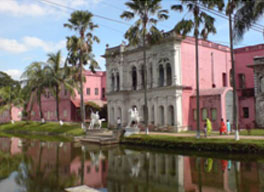b) Ahsan Manjil (The Pink Palace)
Ahsan Manzil situated at Kumartoli of Dhaka on the bank of the Buriganga, was the residential palace and the kachari of the Nawabs of Dhaka. It has been turned into a museum recently.
The construction of the palace was begun in 1859 and completed in 1872. Abdul Ghani named it Ahsan Manzil after his son Khwaja Ahsanullah. At that time the newly built palace was known as Rang Mahal and the earlier one was called Andar Mahal.
Ahsan Manzil is one of the significant architectural monuments of the country. Established on a raised platform of 1 metre, the two-storied palace measures 125.4m by 28.75m. The height of the ground floor is 5 metres and that of the first floor 5.8 metres.
c) Sonargaon – the Old Capital of Bengal
The capital city of Sonargaon, obviously of Hindu origin, was situated on the northern bank of the Dhaleswari, close to the confluence of the Dhaleswari and the Sitalakshya, and also close to that of Old Brahmaputra and the Meghna.
The site of the city is lying about 27 kilometers almost southeast of Dhaka city. The area now known as Panam in Sonargaon, about 2.5 kilometers to the north of the Dhaka-Chittagong highway at Mograpara point.

Bangladesh Folk-Art Museum is situated at Sonargaon. It is open for the tourists from Friday to Wednesday from Morning 10-00 am to afternoon 5-00 pm.
d) Sixty Dome Mosque
The Sixty Dome Mosque (more commonly known as Shait Gambuj Mosque or Saith Gunbad Masjid),a UNESCO World Heritage Site, is a mosque in Bangladesh, the largest in that country from the Sultanate period. It has been described as “the most impressive Muslim monuments in the whole of the Indian subcontinent.
The mosque is locally known as the ‘Shat Gombuj Masjid’, which in Bangla means Sixty Domed Mosque. However, there are 77 domes over the main hall and exactly 60 stone pillars.

It is possible that the mosque was originally referred to as the Sixty Pillared Mosque where Amud meaning column in Arabic/Persian, later got corrupted to Gombuj in Bangla, which means domes.

